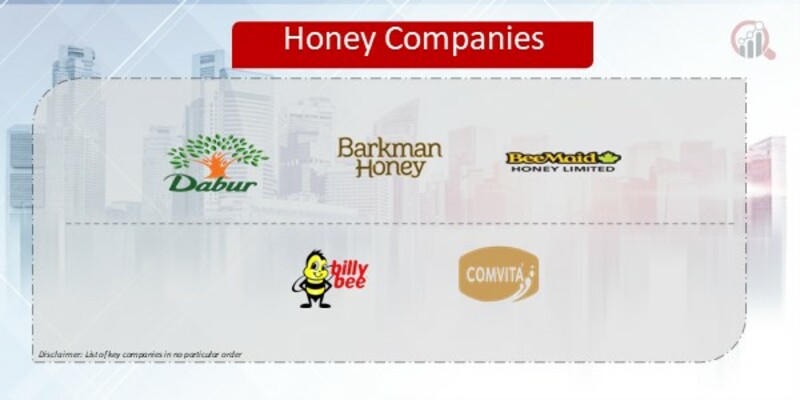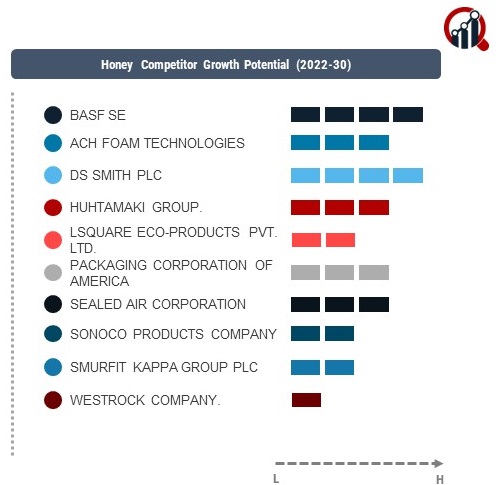Honey Companies
Honey is a natural sweet substance produced by bees from flower nectar. Rich in antioxidants and nutrients, it serves as a versatile sweetener, flavor enhancer, and remedy in culinary and medicinal applications.


Honey is a natural sweet substance produced by bees from flower nectar. Rich in antioxidants and nutrients, it serves as a versatile sweetener, flavor enhancer, and remedy in culinary and medicinal applications.

The Competitive Landscape of the Honey Market
The global honey market is a vital segment within the food industry, providing a natural sweetener with diverse applications and enjoying widespread consumer demand. Key players in this market are strategically positioning themselves to address the increasing demand for high-quality honey, while also navigating challenges such as sustainability, transparency, and regional variations in honey production. This analysis provides an overview of the competitive landscape, covering key players, strategies, market share factors, emerging companies, industry news, current investment trends, and a notable development in 2023.
Key Players:
Dabur India Ltd.
Comvita Ltd.
Barkman Honey Llc
Bee Maid Honey Limited
Billy Bee Honey Products
Strategies Adopted:
The honey market employ various strategies to maintain and enhance their market positions. Strategies encompass sourcing high-quality honey, implementing stringent quality control measures, and addressing sustainability concerns. For example, Barkman Honey, LLC, has been investing in sustainable beekeeping practices, ensuring the ethical sourcing of honey and fostering environmental responsibility. Such strategies not only contribute to meeting consumer demands for transparency and sustainability but also help companies differentiate themselves in a competitive market.
Market Share Analysis:
The honey market involves evaluating multiple factors impacting competitive positioning. Key considerations include honey quality, brand recognition, pricing strategies, distribution networks, and the ability to cater to diverse regional tastes. Companies that effectively balance these factors are better positioned to capture and retain a significant share of the market. Additionally, factors such as effective marketing campaigns, responsiveness to local preferences, and compliance with regional regulations contribute to market differentiation and influence consumer choices.
News & Emerging Companies:
The honey market has witnessed the emergence of new and innovative companies, reflecting the industry's adaptability and potential for growth. In 2023, emerging players like Beekeeper's Naturals entered the market with unique honey products, gaining attention for their focus on medicinal and health-related attributes of honey. These newcomers contribute to the market's diversity, challenging established players and fostering innovation in the honey sector.
Industry Trends:
The honey market revolve around innovation, sustainability, and addressing the demand for pure and unadulterated honey. Key players are investing in research and development to ensure the quality and authenticity of their honey products, exploring advanced technologies for honey processing that retain natural properties. Additionally, investments in marketing and promotional activities contribute to building brand awareness and increasing the adoption of honey across diverse consumer segments.
Current investment trends also highlight the importance of sustainability and ethical sourcing. Companies are increasingly investing in initiatives that promote responsible beekeeping practices, exploring technologies to improve hive health, and supporting community-based beekeeping projects. Furthermore, investments in digital marketing and e-commerce platforms contribute to meeting the growing demand for convenient and accessible honey products.
Competitive Scenario:
The honey market is marked by robust competition among key players striving to establish themselves as leaders in this dynamic sector. Companies differentiate themselves through a combination of honey quality, brand recognition, and a keen understanding of local floral varieties that impact the flavor and aroma of honey. The market is also influenced by factors such as global distribution networks, regulatory compliance, and the ability to adapt to changing consumer preferences, especially in an industry where authenticity and origin play crucial roles.
Recent Development
The honey market was the acquisition of a local honey producer by Dutch Gold Honey. This strategic move marked a response to the increasing demand for locally sourced honey and a desire for traceability in the supply chain. The acquisition allowed Dutch Gold Honey to expand its product portfolio with a range of region-specific honey varieties and strengthen its presence in key markets.
Dutch Gold Honey's acquisition underscored the importance of recognizing regional preferences and the significance of traceability in the honey supply chain. The development positioned the company as not only a global supplier of high-quality honey but also as a supporter of local beekeepers and sustainable honey production practices. This move not only enhanced Dutch Gold Honey's market presence but also contributed to shaping the honey market by highlighting the importance of transparency and regional diversity in honey offerings.
The Competitive Landscape of the Honey Market
The global honey market is a vital segment within the food industry, providing a natural sweetener with diverse applications and enjoying widespread consumer demand. Key players in this market are strategically positioning themselves to address the increasing demand for high-quality honey, while also navigating challenges such as sustainability, transparency, and regional variations in honey production. This analysis provides an overview of the competitive landscape, covering key players, strategies, market share factors, emerging companies, industry news, current investment trends, and a notable development in 2023.
Key Players:
Dabur India Ltd.
Comvita Ltd.
Barkman Honey Llc
Bee Maid Honey Limited
Billy Bee Honey Products
Strategies Adopted:
The honey market employ various strategies to maintain and enhance their market positions. Strategies encompass sourcing high-quality honey, implementing stringent quality control measures, and addressing sustainability concerns. For example, Barkman Honey, LLC, has been investing in sustainable beekeeping practices, ensuring the ethical sourcing of honey and fostering environmental responsibility. Such strategies not only contribute to meeting consumer demands for transparency and sustainability but also help companies differentiate themselves in a competitive market.
Market Share Analysis:
The honey market involves evaluating multiple factors impacting competitive positioning. Key considerations include honey quality, brand recognition, pricing strategies, distribution networks, and the ability to cater to diverse regional tastes. Companies that effectively balance these factors are better positioned to capture and retain a significant share of the market. Additionally, factors such as effective marketing campaigns, responsiveness to local preferences, and compliance with regional regulations contribute to market differentiation and influence consumer choices.
News & Emerging Companies:
The honey market has witnessed the emergence of new and innovative companies, reflecting the industry's adaptability and potential for growth. In 2023, emerging players like Beekeeper's Naturals entered the market with unique honey products, gaining attention for their focus on medicinal and health-related attributes of honey. These newcomers contribute to the market's diversity, challenging established players and fostering innovation in the honey sector.
Industry Trends:
The honey market revolve around innovation, sustainability, and addressing the demand for pure and unadulterated honey. Key players are investing in research and development to ensure the quality and authenticity of their honey products, exploring advanced technologies for honey processing that retain natural properties. Additionally, investments in marketing and promotional activities contribute to building brand awareness and increasing the adoption of honey across diverse consumer segments.
Current investment trends also highlight the importance of sustainability and ethical sourcing. Companies are increasingly investing in initiatives that promote responsible beekeeping practices, exploring technologies to improve hive health, and supporting community-based beekeeping projects. Furthermore, investments in digital marketing and e-commerce platforms contribute to meeting the growing demand for convenient and accessible honey products.
Competitive Scenario:
The honey market is marked by robust competition among key players striving to establish themselves as leaders in this dynamic sector. Companies differentiate themselves through a combination of honey quality, brand recognition, and a keen understanding of local floral varieties that impact the flavor and aroma of honey. The market is also influenced by factors such as global distribution networks, regulatory compliance, and the ability to adapt to changing consumer preferences, especially in an industry where authenticity and origin play crucial roles.
Recent Development
The honey market was the acquisition of a local honey producer by Dutch Gold Honey. This strategic move marked a response to the increasing demand for locally sourced honey and a desire for traceability in the supply chain. The acquisition allowed Dutch Gold Honey to expand its product portfolio with a range of region-specific honey varieties and strengthen its presence in key markets.
Dutch Gold Honey's acquisition underscored the importance of recognizing regional preferences and the significance of traceability in the honey supply chain. The development positioned the company as not only a global supplier of high-quality honey but also as a supporter of local beekeepers and sustainable honey production practices. This move not only enhanced Dutch Gold Honey's market presence but also contributed to shaping the honey market by highlighting the importance of transparency and regional diversity in honey offerings.

© 2024 Market Research Future ® (Part of WantStats Reasearch And Media Pvt. Ltd.)